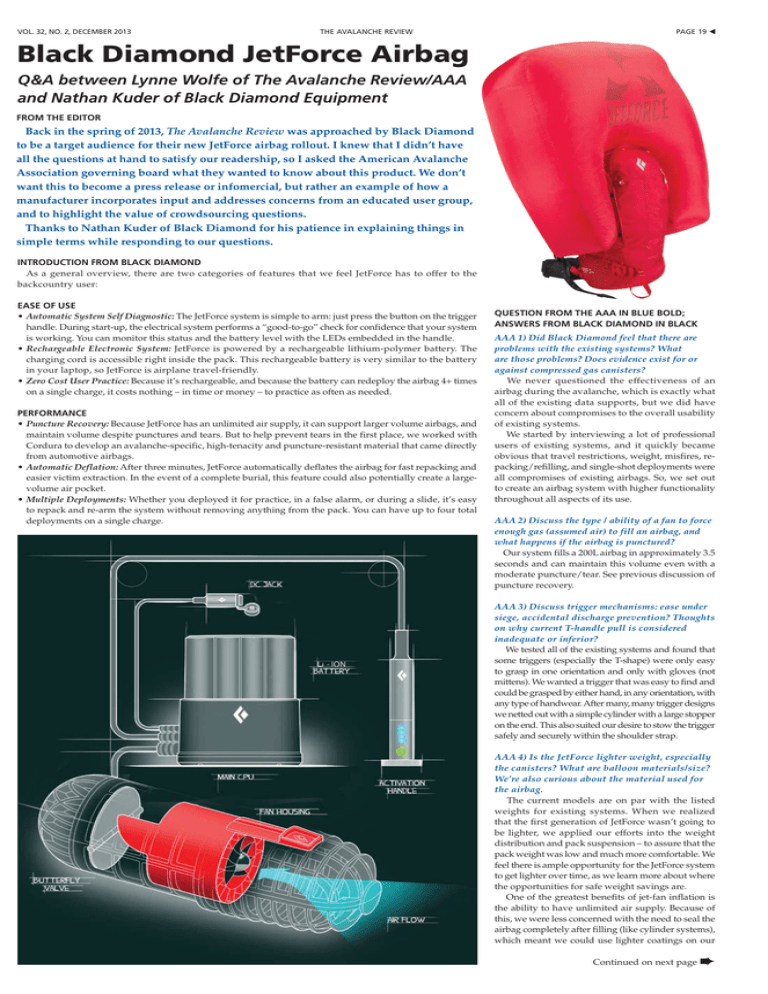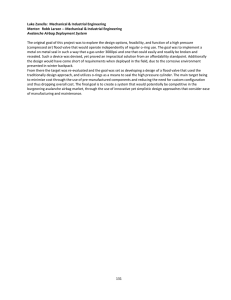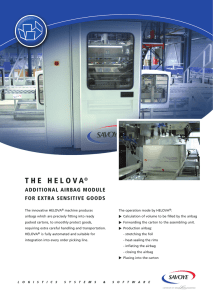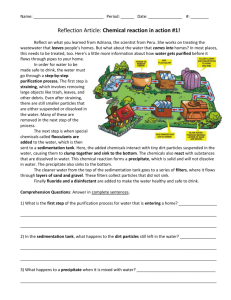black Diamond JetForce Airbag
advertisement

Vol. 32, No. 2, December 2013 the avalanche review PAGE 19 t Black Diamond JetForce Airbag Q&A between Lynne Wolfe of The Avalanche Review/AAA and Nathan Kuder of Black Diamond Equipment From the Editor Back in the spring of 2013, The Avalanche Review was approached by Black Diamond to be a target audience for their new JetForce airbag rollout. I knew that I didn’t have all the questions at hand to satisfy our readership, so I asked the American Avalanche Association governing board what they wanted to know about this product. We don’t want this to become a press release or infomercial, but rather an example of how a manufacturer incorporates input and addresses concerns from an educated user group, and to highlight the value of crowdsourcing questions. Thanks to Nathan Kuder of Black Diamond for his patience in explaining things in simple terms while responding to our questions. Introduction from Black Diamond As a general overview, there are two categories of features that we feel JetForce has to offer to the backcountry user: EASE OF USE •Automatic System Self Diagnostic: The JetForce system is simple to arm: just press the button on the trigger handle. During start-up, the electrical system performs a “good-to-go” check for confidence that your system is working. You can monitor this status and the battery level with the LEDs embedded in the handle. •Rechargeable Electronic System: JetForce is powered by a rechargeable lithium-polymer battery. The charging cord is accessible right inside the pack. This rechargeable battery is very similar to the battery in your laptop, so JetForce is airplane travel-friendly. •Zero Cost User Practice: Because it’s rechargeable, and because the battery can redeploy the airbag 4+ times on a single charge, it costs nothing – in time or money – to practice as often as needed. PERFORMANCE •Puncture Recovery: Because JetForce has an unlimited air supply, it can support larger volume airbags, and maintain volume despite punctures and tears. But to help prevent tears in the first place, we worked with Cordura to develop an avalanche-specific, high-tenacity and puncture-resistant material that came directly from automotive airbags. •Automatic Deflation: After three minutes, JetForce automatically deflates the airbag for fast repacking and easier victim extraction. In the event of a complete burial, this feature could also potentially create a largevolume air pocket. •Multiple Deployments: Whether you deployed it for practice, in a false alarm, or during a slide, it’s easy to repack and re-arm the system without removing anything from the pack. You can have up to four total deployments on a single charge. Question from the AAA in Blue Bold; Answers from Black Diamond in Black AAA 1) Did Black Diamond feel that there are problems with the existing systems? What are those problems? Does evidence exist for or against compressed gas canisters? We never questioned the effectiveness of an airbag during the avalanche, which is exactly what all of the existing data supports, but we did have concern about compromises to the overall usability of existing systems. We started by interviewing a lot of professional users of existing systems, and it quickly became obvious that travel restrictions, weight, misfires, repacking/refilling, and single-shot deployments were all compromises of existing airbags. So, we set out to create an airbag system with higher functionality throughout all aspects of its use. AAA 2) Discuss the type / ability of a fan to force enough gas (assumed air) to fill an airbag, and what happens if the airbag is punctured? Our system fills a 200L airbag in approximately 3.5 seconds and can maintain this volume even with a moderate puncture/tear. See previous discussion of puncture recovery. AAA 3) Discuss trigger mechanisms: ease under siege, accidental discharge prevention? Thoughts on why current T-handle pull is considered inadequate or inferior? We tested all of the existing systems and found that some triggers (especially the T-shape) were only easy to grasp in one orientation and only with gloves (not mittens). We wanted a trigger that was easy to find and could be grasped by either hand, in any orientation, with any type of handwear. After many, many trigger designs we netted out with a simple cylinder with a large stopper on the end. This also suited our desire to stow the trigger safely and securely within the shoulder strap. AAA 4) Is the JetForce lighter weight, especially the canisters? What are balloon materials/size? We’re also curious about the material used for the airbag. The current models are on par with the listed weights for existing systems. When we realized that the first generation of JetForce wasn’t going to be lighter, we applied our efforts into the weight distribution and pack suspension – to assure that the pack weight was low and much more comfortable. We feel there is ample opportunity for the JetForce system to get lighter over time, as we learn more about where the opportunities for safe weight savings are. One of the greatest benefits of jet-fan inflation is the ability to have unlimited air supply. Because of this, we were less concerned with the need to seal the airbag completely after filling (like cylinder systems), which meant we could use lighter coatings on our Continued on next page ➨ u PAGE 20 Airbag Q&A continued from previous page fabric (which translates to higher tear strengths). We worked directly with Cordura to utilize a nylon fiber from automotive airbags, created a custom weave that helped to prevent tearing, and added a silicone coating on the outside to make the bag slippery and more packable. In the end, where we landed is an airbag that is larger, more resistant to punctures and tears, and lighter than existing airbags. AAA 5) What is the shape of balloon? Why? The JetForce system uses an “inverted U” shape. We feel this shape provides the benefit of both the vertical cylinders and the top pillow shapes. AAA 6) Has there been any testing to determine an effective volume of the inflated air bag? Has another company done testing on effective air bag volume? Black Diamond's appears to be 30-50L greater than those currently on the market – why? To my knowledge, there has not yet been any published research on an effective volume, although we would certainly encourage it. The use of a 200L airbag with the JetForce system is intended to maximize the effects of inverse segregation, and increase potential impact protection of the victim. AAA 7) What type of testing has been done with the motor battery system to ensure its reliability in the winter environment? Rechargeability in remote locations? All methods of storing energy are affected by temperature and/or pressure. We have done a lot of testing to prove that a fan/motor/battery system can function even better than a cylinder system in the cold and at altitude. This is the reason we’ve implemented a special cold-resistant Lithium Ion battery, originally developed for the military. The current recharging utilizes a normal 110/220v wall outlet, and any remote charging stations that can support that type of plug will work great. It’s also worth noting that a fully charged battery can provide four deployments and last up to six weeks depending on use. We’re working on making the battery USBchargeable for alternative energy systems. the avalanche review AAA 11) How about the overall pack designs, including detach options, overall usability, and size of pack? We often need larger packs for ski patrol work. Black Diamond overview (volume numbers refer to usable cargo space) Pilot 11: small resort-based or heli/cat client pack Halo 28: medium volume touring or guide pack Saga 40: larger volume guide/patrol/big tour pack with added snowboard carry •Large back panel access to main cargo pocket; •Large, front, separate shovel pocket; •Small organizer pockets •Stow-away helmet storage •Diagonal ski carry •ReActiv suspension with SwingArm shoulder straps •S/M & M/L torso sizes •Available in Fire Red or Black PIEPS overview (numbers refer to usable cargo space) TourRider 24: medium-volume touring or client pack TourPro 34: medium-volume guide pack with upper and back panel access to main •Large back panel access to main cargo pocket; •Large, front, separate shovel pocket; •Small organizer pockets •Stow-away helmet storage •Front ski/snowboard carry •Available in Black/Red or Black/Yellow POC overview (numbers refer to usable cargo space) Thorax 11: small resort-based or heli/cat client pack (based on the BD Pilot) AAA 12) From where is the air pulled in: vents on the pack? Would there be problems if the vents are (partially or otherwise) blocked by snow? There are three main areas that the system uses to pull air into the airbag: lower sidewall intake panel, the entire back panel, and the airbag pocket itself – for a total surface area of over 3ft2 (0.3m2). We’ve also programmed our system to run almost three times longer than needed Vol. 32, No. 2, December 2013 to fill/maintain the airbag volume, to provide safety redundancy against blocked/inefficient intakes. We’ve tested the system while buried in snow and also by intentionally duct taping the vents, and we have yet to experience anything other than a full deployment. A few comments from professional members of the American Avalanche Association • Last year it seemed like maybe five to 10 patrols were providing these to employees. That data seems worth tracking. • Airbags are quickly becoming “Best Practices” within all aspects of the snow safety professional community. From Simon Trautman of the Sawtooth National Forest Avalanche Center: I spent some time this summer talking to avy center directors specifically about airbags. The following is a quick synopsis of what I discovered: •out of the 14 avalanche centers surveyed: four use airbag packs, four have one or more individuals who use airbags, and six do not use them. •When asked if airbags should be standard safety gear, 10 of 14 said yes (although fewer than 10 are willing to require them). The following reasons were common when individuals were asked why they do not carry airbags (in no particular order): •Weight •Price •Functionality •Questions on practicality in treed terrain From Doug Richmond at Bridger Bowl: We had one Bridger patroller with his own. We aren’t buying them yet, but I expect we will in the next few years, during which time I’m hoping for the above improvements – especially weight reduction, and maybe a little price reduction. Price is secondary to safety. Gear is secondary to wisdom. R AAA 8) From a ski patrol director: We can't put a price on safety, but when purchasing 20-plus units, value is important. The other manufacturers have provided significant discounting from MSRPs for patrols, does Black Diamond consider doing the same? And then of course, how much? Black Diamond has always sought to supply professionals with the tools they need at the lowest possible cost and JetForce won’t be any different. We’re still working through the last stages of pricing, but the current target for the Halo 28 retail price is $1000 (most pros qualify for wholesale pricing). AAA 9) Any static from the fan in regard to carrying explosives in your pack? All of the current testing shows there is no addition of static charge from the fan, as it is intentionally separated from the main compartment by multiple layers of fabric and plastic casing. We are working with outside specialists this winter to help determine the static nature of our system. Obviously, our goal is to not increase the danger inherent in carrying explosives. AAA 10) Discuss the pack, please. One of the common themes from the feedback we heard in our early research was a general frustration for some of the existing airbag packs. We’re of the belief that the airbag system has to absolutely be 100% trustworthy; but on any good day, it’s the pack that you interact with almost entirely. We’ve been building winter packs for a long time, so we put a lot of experience and effort into making the whole JetForce family of packs super high functioning, with nothing superfluous. We also worked with PIEPS and POC to create JetForce packs across all three brands that offer a wide array of features and design options. White Dragon 18x18 acrylic on canvas, available at www.erinashlee.com Inspired by graffiti and the endless wonders of nature, Erin Ashlee focuses on bold colors and strong emotion in her work. Originally from the swamplands of Louisiana, Erin followed her love for the mountains to Jackson, Wyoming, at age 19. A self-taught painter, she began drawing at an early age before deciding to pursue art professionally. When not painting, she spends time in the mountains climbing and snowboarding. See cover for more of Erin’s art.


